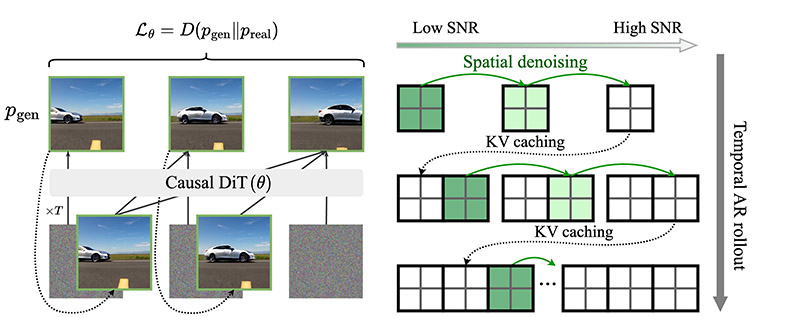Your cart is currently empty!
Self-Forcing wan2.1 : Pioneering Real-Time AI Video Synthesis

The field of video generation has seen remarkable advancements in recent years, with autoregressive diffusion models pushing the boundaries of what’s possible. Among the latest breakthroughs is Self-Forcing Video Generation, a novel approach that bridges the gap between training and inference in autoregressive video diffusion, delivering high-quality, real-time video synthesis. This article dives into the technical underpinnings, practical applications, and transformative potential of Self-Forcing for both professionals and enthusiasts in AI-driven content creation.
Understanding Self-Forcing Video Generation
At its core, Self-Forcing is a training paradigm designed to address the exposure bias problem in autoregressive video diffusion models. Exposure bias occurs when a model, trained on ground-truth data, struggles during inference because it must rely on its own imperfect predictions, leading to cumulative errors over time. Self-Forcing mitigates this by aligning the training process with inference conditions, ensuring models generate coherent and high-fidelity video sequences.
Key Mechanism: Autoregressive Rollout with KV Caching
Self-Forcing introduces an autoregressive rollout during training, where the model generates subsequent frames based on its own previously generated frames, rather than ground-truth data. To make this computationally feasible, Self-Forcing leverages Key-Value (KV) caching, a technique that stores intermediate computations to avoid redundant processing. This enables efficient training and inference, allowing the model to generate video frames in a streaming fashion at approximately 10-16 frames per second (FPS) with a low initial latency of around 0.8 seconds on consumer-grade GPUs like the NVIDIA RTX 4090.

Holistic Video-Level Loss
Unlike traditional frame-by-frame optimization, Self-Forcing employs a holistic video-level loss. This loss function evaluates the quality of the entire generated video sequence, ensuring temporal coherence and alignment with the distribution of real-world videos. By optimizing for the full sequence, Self-Forcing produces videos that maintain consistent motion, identity preservation, and visual fidelity across frames.
Technical Advantages
Self-Forcing stands out for its efficiency and performance, making it a game-changer for real-time video generation. Here are its key technical advantages:
- Few-Step Diffusion: Self-Forcing uses a streamlined diffusion process with fewer sampling steps, reducing computational overhead while maintaining high-quality outputs. This makes it suitable for real-time applications where speed is critical.
- Gradient Truncation: To further optimize training, Self-Forcing employs gradient truncation strategies, which prevent excessive memory usage and enable scalability on consumer hardware.
- Streaming Capability: By generating frames sequentially with low latency, Self-Forcing supports streaming applications, such as live video synthesis for gaming, virtual environments, or interactive media.
- Keyframe-Guided Generation: Self-Forcing excels at generating videos from sparse keyframes (e.g., a starting and ending image) combined with text prompts. This allows creators to define the narrative arc while the model fills in smooth, coherent transitions.
Practical Applications
Self-Forcing Video Generation has a wide range of applications for both professionals and enthusiasts:
- Content Creation: Filmmakers and animators can use Self-Forcing to generate dynamic video sequences from text prompts and keyframes, streamlining pre-visualization and storyboarding workflows.
- Gaming and Virtual Reality: Real-time video synthesis enables immersive environments where dynamic scenes adapt to player inputs or narrative changes.
- Advertising and Marketing: Marketers can create personalized, high-quality video ads with minimal manual effort, leveraging text prompts to tailor content to specific audiences.
- AI Research: Researchers can explore Self-Forcing as a foundation for advancing autoregressive diffusion models, particularly in domains requiring temporal consistency, such as video prediction or simulation.
Example Use Case
Imagine a content creator tasked with producing a promotional video. Using a prompt like, “A futuristic cityscape at dusk with flying cars and neon lights”, and providing a starting keyframe of a city skyline and an ending keyframe of a close-up on a sleek vehicle, Self-Forcing can generate a smooth, 5-second video clip. The model ensures consistent lighting, coherent motion of vehicles, and preservation of the city’s aesthetic, all rendered in real-time.
Implementation and Tools
Self-Forcing has been integrated into accessible tools like ComfyUI, a popular platform for AI-driven content creation. The Wan Video Wrapper node in ComfyUI implements Self-Forcing, allowing users to experiment with video generation using pre-trained models. These tools democratize access, enabling both professionals with robust hardware and enthusiasts with consumer GPUs to explore the technology.
Sample Workflow in ComfyUI
- Input Keyframes: Upload a starting and ending frame to define the video’s narrative.
- Text Prompt: Provide a descriptive text prompt to guide the model’s style and content.
- Configure Model: Select a Self-Forcing-enabled model (e.g., based on the research framework from Adobe and UT Austin).
- Generate Video: Run the model to produce a video sequence, tweaking parameters like frame rate or duration as needed.
Limitations and Future Directions
While Self-Forcing is a significant leap forward, it has some limitations:
- Extrapolation Challenges: Videos longer than the training duration (e.g., >5 seconds) may exhibit quality degradation. Techniques like sliding window extrapolation help mitigate this by generating videos in overlapping segments.
- Hardware Dependency: While optimized for consumer GPUs, performance scales with hardware capabilities, and lower-end systems may struggle with real-time generation.
- Fine-Tuning Needs: Achieving domain-specific results (e.g., hyper-realistic human faces) may require additional fine-tuning of pre-trained models.
Future research is likely to focus on extending video duration, improving robustness for diverse content types, and integrating Self-Forcing with other generative paradigms, such as multimodal diffusion or reinforcement learning.
Why It Matters
Self-Forcing Video Generation represents a paradigm shift in how we approach video synthesis. By addressing exposure bias and enabling real-time, high-fidelity video generation, it empowers creators to produce dynamic content with unprecedented ease and efficiency. For professionals, it’s a tool to accelerate workflows and push creative boundaries. For enthusiasts, it’s an accessible entry point into the world of AI-driven video creation.
Getting Started
To explore SELF-Forcing, check out the original research paper, “Self Forcing: Bridging the Train-Test Gap in Autoregressive Video Diffusion” (arXiv:2506.08009), published by Adobe and the University of Texas at Austin in 2025. For hands-on experimentation, platforms like ComfyUI offer a practical starting point. Whether you’re a seasoned AI researcher or a creative enthusiast, Self-Forcing opens up exciting possibilities for the future of video generation.
Vset3D 2025 virtual production software

